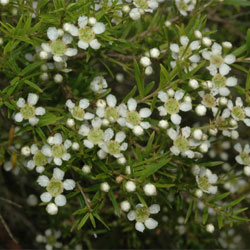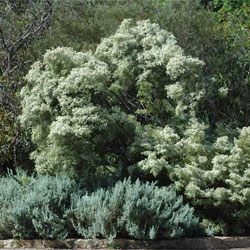Babingtonia 'Howie's Feathertips'
 |
 |
formerly known as Baeckea 'Howie's Feathertips'
Following taxonomic studies on the Baeckea virgata group of species by A.R. Bean in 1999, Baeckea 'Howie's Feathertips is now classified as a species of Babingtonia, Babingtonia similis. |
Babingtonia 'Howie's Feathertips' nom. cult.
There are many plants that benefit from the specialised environmental conditions provided by rockeries for successful growth. Others will grow well in a wide range of conditions, but are shown to advantage by placing them in a rock garden. Baeckea 'Howie's Feathertips' is such a plant.
This registered cultivar is a Baeckea seedling variant, selected by S. A. and J. M. Howie's nursery in Coopers Plains, Queensland. It forms a small, dense shrub growing to 50 cm high and up to 1 m wide. Its weeping habit makes it ideal for growing over rock walls or ledges.
The branchlets are numerous and pendulous, with narrow leaves. Apart from its habit the flowers of B. 'Howie's Feathertips' are a significant and prominent feature. These are borne in small clusters at the ends of the branchlets and are a brilliant white, 6 mm across.
Some of the 75 or so Baeckea species are large shrubs up to 4 m tall, and are usually adaptable plants, tolerating a wide range of soil types and soil moisture conditions. The cultivar is equally adaptable, but grows best in a moist, well-drained, sunny situation. Maximum flowering potential is also achieved under these conditions.
As for many plants in the Myrtaceae family, this cultivar is susceptible to periodic attacks by the webbing moth caterpillar (family Pyralidae). This pest is easily recognised by the matted lumps of 'webbing' and dead leaves usually partially concealed amongst the foliage and constructed around or between the stems. The caterpillar emerges at night to feed on the foliage and shelters during daylight hours. The webbing may be readily removed by hand and crushed. Chemical control is difficult; contact local experts for advice if infestations are severe.
Baeckea 'Howie's Feathertips' remains dense and pruning is not usually necessary. A general purpose NPK fertiliser applied in early spring and early autumn is advantageous.
Another attractive cultivar registered by Howie's Nursery is B. 'Howie's Sweet Midget'. This is also a selected seedling variant which grows to 30 cm high x 60 cm wide. It is compact and has extremely fine foliage. Its compact, layered habit could be used to great advantage in a rockery. Both cultivars must be propagated vegetatively to ensure the cultivar form is retained. Seedlings grown from either of these cultivars could revert to the more normal forms of Baeckea.
Text by Geoff Butler, ANBG (1981)
Name meaning: BaeckeaBaeckea - after Dr Abraham Baeck (1713-95), a Swedish naturalist and physician. |
![An Australian Government Initiative [logo]](/images/austgovt_brown_90px.gif)

